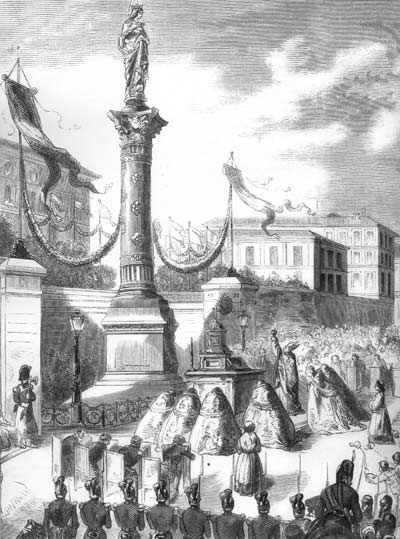Such was the name given by the people of Marseilles to the monument erected by Bishop de Mazenod in honour of Mary Immaculate in order to keep fresh in the minds of people the definition of the dogma of the Immaculate Conception proclaimed by Pope Pius IX on December 8, 1854.
This definition was a great event in the life of saint Eugene. He felt himself carried away into the joy of heaven as he notes in his diary: “In that moment, I seemed to see the heavens opening over our heads and showing us totally revealed the joy of the entire Church triumphant… I seemed to see Jesus Christ our Lord congratulating his divine Mother… and Saint Joseph rejoicing at the happiness of his spouse to whom he is so closely united in heaven.” (Quoted in REY II, p. 528) Bishop de Mazenod was not able to contain his joy when he learned how much the diocese of Marseilles was united to the joy of the whole Church as Bishop Jeancard tells us in his Mélanges historiques: “Bishop [de Mazenod] was enthralled at all he heard about it. He talked to everyone about it.” (Quoted in REY II, p. 530) He wanted to retain a visible memorial of this joy. Also, he noted in the program of November 21, 1855: “Letter to the mayor of Marseilles. Project for a commemorative monument for the promulgation of the dogma of the Immaculate Conception to be erected at the end of Napoleon boulevard. Request for authorization to be able to choose this site.” The municipal council sent the bishop their unanimous approval of this petition.
On the first anniversary of the definition of the dogma, Bishop de Mazenod’s diary records this: “We wanted to conserve the memory of this event by laying the cornerstone of a monument which will always bring to the mind of future ages both the declaration of truth in honour of the Mother of God and the piety with which we have responded to the voice from heaven.” (see REY II, p. 555) In his pastoral letter of December 21, 1855, the bishop of Marseilles called for the participation of all the faithful. “What really must happen is that every faithful soul should contribute to this work. Each one should consider it a blessing to bring his offering.”

The monument was unveiled on December 8, 1857. In his enthusiasm, Bishop de Mazenod wrote personally to Pius IX to tell him how the ceremony took place. He began by describing the monument: “It is made of Carrara marble; it consists of a Byzantine column of rather large dimensions placed upon a fine pedestal which is equally of marble and which bears on his summit the statue of Mary Immaculate.” To start things off, there was a procession which took two hours; then the bishop celebrated Mass at the foot of the statue. The people of Marseilles were not satisfied with merely a morning celebration. Bishop de Mazenod continued in his letter to Pius IX: “In the evening, the whole city was illuminated, even the most humble dwellings were lit up, charity drew the poor into the common joy.”
At the site of this monument, there was subsequently built a great staircase in front of the railway station. As a result, the monument was removed a little further away. An inscription briefly describes the history of the memorial erected in honour of Mary Immaculate. The entire whole is very well maintained by the municipality of Marseilles. The effulgence of the statue has very deservedly won it the name of The Golden Virgin.
René Motte, o.m.i.
